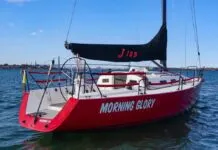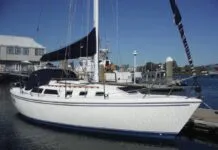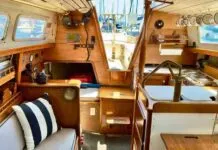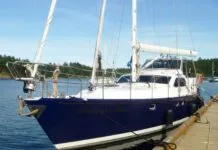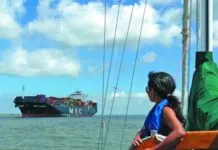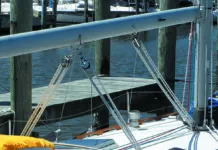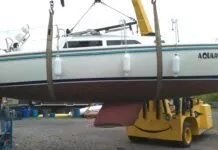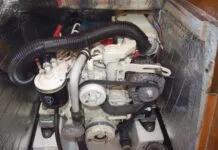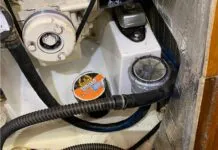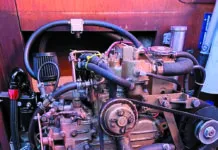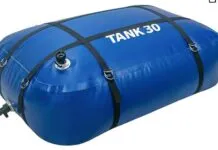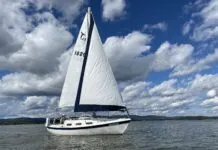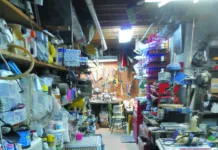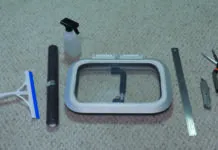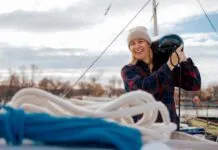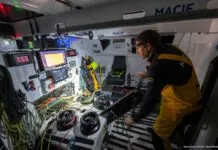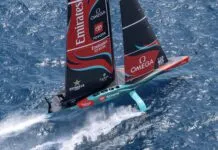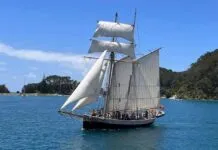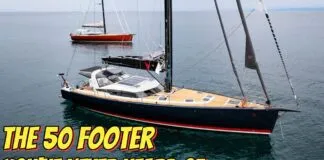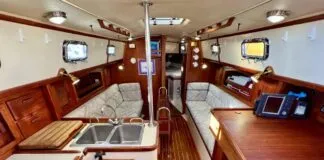The marvel called radar is great to have aboard, especially when an approaching fog bank is about to compress your world into a small disk of fear.
But the radome can be a problem. In recent issues, Practical Sailor has addressed off-the-shelf options on how to mount the radome.
Mast mounts, of which there are many, were assessed in the September, 1998 issue. Scanstrut was the top choice. Mast-mounted radomes currently are overwhelmingly preferred. In a small survey in our neighborhood, the ratio of mast/backstay/pole mounts was 61%/17%/22%, despite the fact that flailing foresails are a threat to any radome unprotected by a guard. Few guards entirely preclude fouled lines and jib leeches get frayed.
Gimbaled backstay mounts, of which there are but three, were in the October 1, 1998 issue. The Waltz was the Best Buy. A wish I had question in the above-mentioned survey nearly doubled the number who wanted gimbaling and changed the mast/backstay/pole ratio to 47%/33%/20%. Having the radar scanner remain fairly level is a big plus with some boat owners.
However, about half the respondents in our mini-survey said they didnt care about gimbaling because theyre usually under power when using radar. In truth, most radar sets have a beam width of 25, which means that the signal loss begins when the boat is heeled 15.
Now, finally, wrapping up this subject, here is a look at seven makes (and even more varieties) of pole mounts. It should be noted here that if one wants a continuously gimbaled radome, one can be mounted on a pole with a bit of fussing and extra expense. Further, despite the fact that the maker (Edson) of a radome with a hydraulically adjusted radome platform sells very few of them (the hydraulic kit costs an extra $675), and another firm (Nautical Engineering) is thinking of giving up its electrically powered leveler, a third manufacturer (Garhauer) has a new pole that provides mechanical leveling.
In this review are radar poles from Devitt, Edson, Forespar, Garhauer, Lilly, Nautical Engineering and Scanstrut.
Lilly
At the basic level, meaning the most economical, is Lilly.
The Long Island company, better known for radio antenna mounts, uses a slender 1-1/4″ OD aluminum tube with a 1/4″ wall thickness. The white powder-coated tube is available in 5′ and 6′ lengths. The tubes alone retail for $100 and $130, respectively.
The thick wall permits Lilly to attach-with male threads at the top and the female at the bottom-the radome platform (several sizes, with pre-drilled holes) and the deck fitting, which is further locked down with an Allen screw. The deck fitting can be a fixed stainless base (which might need to be shimmed if the deck is not level), a universal joint as shown in the photo, or any marine radio antenna base. The universal joint makes it easy to install and lower the pole, but the bolts would need very positive tightening.
No matter what deck fitting is used, Lillys owner, John Jennings, said the rather heavy tube must be supported with tangs or a bracket attached to the stern pulpit.
The tube has slots, top and bottom, through which the radar cable must be fed.
A package including a radome platform, the pole, a deck fitting and a support bracket sells for $261, with an extra $6.50 for a backing plate.
C. P. Devitt
Located in Marblehead, Massachusetts, the C. P. Devitt company, best known for its instrument pods, produces two sizes of radar pole mounts based on thick-wall aluminum tubing that can be had anodized or powder-coated. Devitts powder-coating is not quite as slick as that seen on other makes.
The pole for large radomes is telescoping (from 5′ to 8′). For smaller radomes, the 2-1/2″ OD poles are cut to length.
Both are available with tabernacle deck bases that permit easy lowering. The tabernacle also makes it easy to fit the pole to a deck that is not level, although there are limits to how much rotation can be utilized for leveling and still retain the fore-and-aft lowering function.
If the tabernacle is used, some means of keeping the pole vertical must be employed. An assortment of pole rings, support brackets and tangs are available.
Most of Devitts work is custom-ordered, but a pole mount package, described as very complete, for a large radome lists for $460. A smaller version lists for $399. A lifting boom option, to hoist outboard motors, is $129.
Nautical Engineering
The two pole mounts, telescoping and fixed, made by Nautical Engineering are similar to those made by Devitt in that a tabernacle base is used. Both run the cable completely inside the tube.
Nautical Engineerings instructions indicate that if the cable is properly rigged, the telescoping pole (5′ to 7′) can be lowered in place, which makes for easier mounting and service. The difference between 5′ and 7′ is significant.
Nautical Engineerings anodizing appears to be excellent.
Available at modest costs are bracing components, including a good pole ring, U-brackets, L-brackets, support arms, clamps and Nyloc nuts and bolts.
NEs fixed length pole kit lists for $396. It is 7′ long, but can be shortened. The telescoping model is $429. The electrically operated tilting platform version is $895.
An option is NEs 12″ x 26″ pedestal antenna array, a polished stainless cage meant for the mounting of other antennas, lights, etc. It lists for $375.
Scanstrut
The British-made Scanstrut radar poles are simple and strong. They come in two sizes, one large with a 4″ OD pole, the other small with a 3″ OD pole. They come in 1′, 2′, 4′ and 6′ lengths.
What makes them simple is that the fixed cast aluminum top platforms are identical to the deck bases. That means-and its a distinct disadvantage-that you need a lot of room on deck to mount either pole.
The small model has square end fittings that measure 8-1/2″. The large pole has 10-1/2″ round end fittings.
Scanstrut provides an option, however, for the 4″ pole. It is in the form of a 7-1/2″ round split collar, which can be used on or under the deck and also as a base shimmed level and mounted down low in the hull. A mere $225 a pop.
Everything is beautifully powder-coated. The radar cable goes entirely inside the tube.
The 6′ Scanstrut poles, which would not need to be stiffened with collars and tangs, list for $395 and $475.
Scanstrut has for $180 a stainless cage array for other aerials and lights.
It also has a unique fiberglass arm that angles out below and extends up past and behind the radome. Sort of a T with the long leg bent under the radome, its hollow and meant to conceal and protect the wiring of whatever you choose to mount above the radome. Scanstrut doesn’t know what to call it. The catalog says its a GRP Structure, Part No SC60. The price list says its a Deluxe F/G Aerial Support. They think highly of it…$1,150 highly.
Edson
Widely known for its steering systems, pumps and davits, Edson International calls its radar poles towers. The NAVCOM Tower System, engineered to avoid customizing, is a bolt-together method that utilizes a few components in multiple configurations.
In two full pages of its catalog, Edson explains how to assemble the parts, most of which are high-grade aluminum, either hard-anodized or with a baked-on urethane paint.
Henry Keene, Jr., Edsons general manager, sent a foot-long sample of coated tubing with the comment, Hit it with a hammer to test the paint job.
Like most other radar pole manufacturers, Edson makes two basic sizes for small and large radomes. The standard pole is 2-3/8″ anodized; the large pole is 3-1/2″ painted. Lengths run up to 12′.
About a dozen and a half standard parts (including four radome platforms) permit installation of the poles on virtually any boat-power or sail. From another 35 parts (struts, brackets, arms, hoops, etc.), one can create a tower to mount everything, including a stuffed owl.
Besides being a complete line, Edson offers one other unique feature. Besides deck mount bases, space saver bases, side mounts and flanged bases for through-deck installations, Edson makes fiberglass tubes that, cut to length, run from the deck to a structural fixed point lower down. Properly glassed in place, such a tube makes for the strongest of all supports for any pole.
The Edson package for a small radome on an anodized 2-3/8″ pole fitted in a flange deck base with a rail mount bracket for extra support lists for $417. A large fixed pole gets up around $700. Adding options such as those shown in the line drawing on page 1 can push the tab well past $2,000. If you want the hydraulic leveling kit, add $675.
Forespars Lightweight
If a pole-mounted radome is placed on the stern deck close enough to tie into the stern pulpit, it can add about 50 lbs. where 50 lbs. is not wanted. Boats that are raced especially dislike unnecessary weight in the ends (or aloft).
To address the problem, Forespar has just introduced a pole made of carbon fiber. It also has a sealed 12V linear drive leveler (its aircraft gear) and a complete set of mounting options (fixed and swiveling deck plates or through-deck collars and bases, as well as a pulpit brace).
It comes with either a 15″ platform for 24-mile radomes or a 12″ platform for shorter range sets. There are carbon fiber extension arms for other antennas and lights.
The carbon fiber pole takes paint very nicely.
The entire system weighs less than 10 lbs., not counting the radome and cable, of course.
In addition, it eliminates or reduces some of the corrosion that can result from using an aluminum pole and stainless fasteners.
Nice? Very. The downside? The 12″ model lists for $2,295; the 15″ for $2,395. Only a strong desire to own the very best will induce a buyer to lay down that kind of money.
The Heavyweight: Garhauer
The California company called Garhauer has a new, semi-customized all-stainless pole with a unique adjustable platform. As with most Garhauer gear, it is a heavyweight. However, it comes in at very reasonable cost.
The basic pole is a 2″ polished, thick-wall stainless tube. It has a welded plate base that, if needed, can be angled (by Garhauer) to suit a deck that is not exactly level. Included for additional needed support are bracket arms to brace the pole to the stern pulpit or a stainless, hinged rail clamp.
The top is another stainless plate supported by two shallow triangular beams with a single axle. It will move about 30 in either direction.
The clever thread-drive adjustment (see photo) is via a large knurled handle turning a threaded rod attached to welded ears on the tube and radome platform.
Garhauer also offers an optional swiveling outboard hoist (more stainless steel) that is easily mounted when needed and removed for stowage.
The Garhauer pole without the outboard hoist is $225. With the hoist, its $375.
Some Observations
Deciding how to mount a radome requires some analysis.
Here are some considerations.
The cheapest is a mast mount, but the installation is not easy, its difficult to service, if you unstep the mast it must be dismounted, and the leech of the jib will get frayed and maybe even damage the radome. Placed high, it has the best range.
A pole-mounted radome is more expensive, even for small, simple ones, and, unless youre lucky, is most difficult to install. However, it gets the radome up and out of the way, provides a place for other equipment and is independent of the mast. Whether a pole is more unsightly is a matter of opinion. If you want the radome platform gimbaled or electrically or hydraulically leveled, it will be expensive. The range is not quite as good as with a high-up mast mount.
A gimbaled mount hung on the backstay is more expensive than a mast or basic pole mount, but it is, by far, the easiest to install. Its fairly easy to dismount if it needs service or the mast must be unstepped. Gimbaling has distinct advantages and if hung high enough the range can be acceptable.
The Bottom Line
Based on our three-part series, here are the choices.
For mast mounts, there are no unacceptable makes. Edson is top of the line, but Scanstrut offers, in our opinion, the best combination of low weight, quality and cost and is the Best Buy.
For gimbaled backstay mounts, the Questus is a jewel but the Waltz is the Best Buy.
If its a pole, the new lightweight powerhouse from Forespar is the Top Pole; Edson makes the most complete, high quality, adaptable line and gets a strong vote for its fiberglass tube option; Nautical Engineerings adjustable pole is an excellent buy, and Garhauer is the Best Buy…if you don’t mind the weight.
Contacts- C.P. Devitt, PO Box 55, Tiverton, RI 02878; 401/624-4124. D. Lilly & Co., 25 Linden Place, Port Jefferson, NY 11776; 516/473-7779. Edson, 146 Duchaine Blvd., New Bedford, MA 02745-1292; 508/995-9711. Forespar, 22322 Gilberto, Rio Santa Margarita, CA 92688; 714/858-8820. Garhauer, 1082 Upland, CA 91786; 909/985-9993. Nautical Engineering, 700 Doheny, Northville, MI 48167; 248/349-1034. Questus, Hood Yacht Systems (Pompanette, Inc.), Box W, Charlestown, NH 03603; 603/826-4125. Scanstrut, PYI, 7831 196th St. SW, Edmonds, WA 98020; 425/670-8915. Waltz, Performance Marine Specialties, Inc., 21785 SW TV Hwy., Beaverton, Oregon 97006; 503/642-5200.



